Monitoring and Analysis of Dynamic Characteristics of Super High-rise Buildings using GB-RAR: A Case Study of the WGC under Construction, China
Abstract
:1. Introduction
2. Methodology
2.1. Reference Time Selection
2.2. Window Processing
2.3. Differential Interferometric Processing
2.4. Gross Error Detection
2.5. Wavelet Analysis Denoising
3. Experiment Description
3.1. Monitored Object
3.2. Monitoring Scheme Design
3.3. Measurement Campaign
4. Results and Discussion
4.1. Horizontal Displacement and Amplitude Extraction Analysis
4.2. Roof Displacement Trajectory Analysis
4.3. Correlation between Roof Displacement and Temperature Changes
5. Conclusions
- (1)
- During the monitoring of the WGC, the GB-RAR effectively extracted the dynamic characteristics (e.g., horizontal displacement and oscillation amplitude) of the building. The maximum horizontal displacement amplitudes at the top of the building in the north–south and east–west directions were 18.84 and 15.94 mm respectively, and the corresponding accuracies were 0.15 and 0.17 mm, respectively, suggesting that the accuracy of GB-RAR monitoring was high. However, the monitoring accuracy gradually decreased with the increase in floors. The roof displacement trajectory of the WGC was clearly identified. The displacement trajectory was accompanied by slight fluctuation, which may be caused by the combined influences of construction vibration, wind load, and other factors. The results demonstrate that the GB-RAR is effective for dynamic monitoring of super high-rise buildings.
- (2)
- A certain negative correlation was identified between the temperature and displacement changes in the north–south and east–west directions at the roof of the building, and the correlation between the displacement changes in the east–west direction and the temperature changes was strong.
Author Contributions
Funding
Acknowledgments
Conflicts of Interest
References
- Chen, Q.J.; Yuan, W.Z.; Li, Y.C.; Cao, L.Y. Dynamic response characteristics of super high-rise buildings subjected to long-period ground motions. J. Cent. S. Univ. 2013, 20, 1341–1353. [Google Scholar] [CrossRef]
- Adachi, F.; Fujita, K.; Tsuji, M.; Takewaki, I. Importance of interstory velocity on optimal along-height allocation of viscous oil dampers in super high-rise buildings. Eng. Struct. 2013, 56, 489–500. [Google Scholar] [CrossRef] [Green Version]
- Li, Q.S.; He, Y.C.; He, Y.H.; Zhou, K.; Han, X.L. Monitoring wind effects of a landfall typhoon on a 600 m high skyscraper. Struct. Infrastruct. Eng. 2019, 15, 54–71. [Google Scholar] [CrossRef]
- Silva, I.D.; Ibañez, W.; Poleszuk, G. Experience of Using Total Station and GNSS Technologies for Tall Building Construction Monitoring. In Proceedings of the International Congress and Exhibition "Sustainable Civil Infrastructures: Innovative Infrastructure Geotechnology, Sharm El Sheikh, Egypt, 15–19 July 2017. [Google Scholar]
- Xu, J.; Jo, H. Development of High-Sensitivity and Low-Cost Electroluminescent Strain Sensor for Structural Health Monitoring. IEEE Sens. J. 2016, 16, 1962–1968. [Google Scholar] [CrossRef]
- Li, Q.S.; Xiao, Y.Q.; Wong, C.K. Full-scale monitoring of typhoon effects on super tall buildings. J. Fluids Struct. 2005, 20, 697–717. [Google Scholar] [CrossRef]
- Xia, Y.; Zhang, P.; Ni, Y.Q.; Zhu, H.P. Deformation monitoring of a super-tall structure using real-time strain data. Eng. Struct. 2014, 67, 29–38. [Google Scholar] [CrossRef] [Green Version]
- Wang, T.Y.; Xu, Y.M. Research on Dynamic Characteristic Monitoring Methods for Super High-rise Building. Bull. Surv. Map. 2017, 4, 89–92. [Google Scholar]
- Zhang, X.; Zhang, Y.Y.; Li, B.F.; Qiu, G.X. GNSS-Based Verticality Monitoring of Super-Tall Buildings. Appl. Sci. 2018, 8, 991. [Google Scholar] [CrossRef] [Green Version]
- Li, Q.S.; Zhi, L.H.; Yi, J.; To, A.; Xie, J.M. Monitoring of typhoon effects on a super-tall building in Hong Kong. Struct. Control Health 2014, 21, 926–949. [Google Scholar] [CrossRef]
- Li, Q.S.; Yi, J. Monitoring of dynamic behaviour of super-tall buildings during typhoons. Struct. Infrastruct. Eng. 2016, 12, 289–311. [Google Scholar] [CrossRef]
- Hwang, J.; Yun, H.; Park, S.K.; Lee, D.; Hong, S. Optimal Methods of RTK-GPS/Accelerometer Integration to Monitor the Displacement of Structures. Sensors 2012, 12, 1014–1034. [Google Scholar] [CrossRef] [PubMed] [Green Version]
- Casciati, F.; Fuggini, C. Monitoring a steel building using GPS sensors. Smart Struct. Syst. 2011, 7, 349–363. [Google Scholar] [CrossRef]
- Gentile, C.; Bernardini, G. An interferometric radar for non-contact measurement of deflections on civil engineering structures: Laboratory and full-scale tests. Struct. Infrastruct. Eng. 2010, 6, 521–534. [Google Scholar] [CrossRef]
- Santana, J.; Hoven, R.V.D.; Liempd, C.V.; Colin, M.; Saillen, N.; Zonta, D.; Trapani, D.; Torfs, T.; Hoof, C.V. A 3-axis accelerometer and strain sensor system for building integrity monitoring. Sens. Actuators A Phys. 2012, 188, 141–147. [Google Scholar] [CrossRef]
- Guo, Y.L.; Kareem, A.; Ni, Y.Q.; Liao, W.Y. Performance evaluation of Canton Tower under winds based on full-scale data. J. Wind Eng. Ind. Aerodyn. 2012, 104, 116–128. [Google Scholar] [CrossRef]
- Xiong, C.; Niu, Y. Investigation of the Dynamic Behavior of a Super High-rise Structure using RTK-GNSS Technique. KSCE J. Civ. Eng. 2019, 23, 654–665. [Google Scholar] [CrossRef]
- Yang, K.; Yan, L.; Huang, G.; Chen, C.; Wu, Z.P. Monitoring Building Deformation with InSAR: Experiments and Validation. Sensors 2016, 16, 2182. [Google Scholar] [CrossRef]
- Wu, W.Q.; Cui, H.T.; Hu, J.; Yao, L.N. Detection and 3D Visualization of Deformations for High-Rise Buildings in Shenzhen, China from High-Resolution TerraSAR-X Datase. Appl. Sci. 2019, 9, 3818. [Google Scholar] [CrossRef] [Green Version]
- Bardi, F.; Raspini, F.; Ciampalini, A.; Kristensen, L.; Rouyet, L.; Lauknes, T.R.; Frauenfelder, R.; Casagli, N. Space Borne and Ground Based InSAR Data Integration: The Åknes Test Site. Remote Sens. 2016, 8, 237. [Google Scholar] [CrossRef] [Green Version]
- Bardi, F.; Frodella, W.; Ciampalini, A.; Bianchini, S.; Ventisette, C.D. Integration between ground based and satellite SAR data in landslide mapping: The San Fratello case study. Geomorphology 2014, 223, 45–60. [Google Scholar] [CrossRef]
- Guo, J.M.; Zhou, L.; Yao, C.L.; Hu, J.Y. Surface Subsidence Analysis by Multi-Temporal InSAR and GRACE: A Case Study in Beijing. Sensors 2016, 16, 1495. [Google Scholar] [CrossRef] [PubMed] [Green Version]
- Ji, L.; Zhang, Y.; Wang, Q.; Wan, Y.; Li, J. Detecting land uplift associated with enhanced oil recovery using InSAR in the Karamay oil field, Xinjiang, China. Int. J. Remote Sens. 2016, 37, 1527–1540. [Google Scholar] [CrossRef]
- Farrar, C.R.; Darling, T.W.; Migliori, A.; Baker, W.E. Microwave interferometer for non-contact vibration measurements on large structures. Mech. Syst. Signal Process. 1999, 13, 241–253. [Google Scholar] [CrossRef] [Green Version]
- Tapete, D.; Casagli, N.; Luzi, G.; Fanti, R.; Gigli, G.; Leva, D. Integrating radar and laser-based remote sensing techniques for monitoring structural deformation of archaeological monuments. J. Archaeol. Sci. 2013, 40, 176–189. [Google Scholar] [CrossRef] [Green Version]
- Monserrat, O.; Crosetto, M.; Luzi, G. A review of ground-based SAR interferometry for deformation measurement. ISPRS J. Photogramm. 2014, 93, 40–48. [Google Scholar] [CrossRef] [Green Version]
- Marchisio, M.; Piroddi, L.; Ranieri, G.; Sergio, V.C.; Paolo, F. Comparison of natural and artificial forcing to study the dynamic behaviour of bell towers in low wind context by means of ground-based radar interferometry: The case of the Leaning Tower in Pisa. J. Geophys. Eng. 2014, 11, 5004–5013. [Google Scholar] [CrossRef]
- Roy, A.K.; Gangal, S.A.; Bhattacharya, C. Calibration of High Resolution Synthetic Aperture Radar SAR Image Features by Ground Based Experiments. IETE J. Res. 2017, 63, 381–391. [Google Scholar] [CrossRef]
- Pieraccini, M.; Miccinesi, L.; Rojhani, N. A GBSAR Operating in Monostatic and Bistatic Modalities for Retrieving the Displacement Vector. IEEE Geosci. Remote Sens. 2017, 14, 1494–1498. [Google Scholar] [CrossRef]
- Pieraccini, M.; Fratini, M.; Parrini, F.; Macaluso, G.; Atzeni, C. High speed CW step frequency coherent radar for dynamic monitoring of civil engineering structures. Electron. Lett. 2004, 14, 907–908. [Google Scholar] [CrossRef]
- Zhou, L.; Guo, J.M.; Hu, J.Y.; Ma, J.; Wei, F.H.; Xue, X.Y. Subsidence analysis of ELH Bridge through ground-based interferometric radar during the crossing of a subway shield tunnel underneath the bridge. Int. J. Remote Sens. 2018, 39, 1911–1928. [Google Scholar] [CrossRef]
- Stabile, T.A.; Perrone, A.; Gallipoli, M.R.; Ditommaso, R.; Ponzo, F.C. Dynamic Survey of the Musmeci Bridge by Joint Application of Ground-Based Microwave Radar Interferometry and Ambient Noise Standard Spectral Ratio Techniques. IEEE Geosci. Remote Sens. 2013, 10, 870–874. [Google Scholar] [CrossRef]
- Luzi, G.; Monserrat, O.; Crosetto, M. The Potential of Coherent Radar to Support the Monitoring of the Health State of Buildings. Res. Nondestruct. Eval. 2012, 23, 125–145. [Google Scholar] [CrossRef]
- Atzeni, C.; Bicci, A.; Dei, D.; Fratini, M.; Pieraccini, M. Remote Survey of the Leaning Tower of Pisa by Interferometric Sensing. IEEE Geosci. Remote Sens. 2010, 7, 185–189. [Google Scholar] [CrossRef]
- Gentile, C. Application of microwave remote sensing to dynamic testing of stay-cables. Remote Sens. 2010, 2, 36–51. [Google Scholar] [CrossRef] [Green Version]
- Montuori, A.; Luzi, G.; Bignami, C.; Gaudiosi, I.; Stramondo, S.; Crosetto, M.; Buongiorno, M.F. The Interferometric Use of Radar Sensors for the Urban Monitoring of Structural Vibrations and Surface Displacements. IEEE J. Sel. Top. Appl. Earth Obs. Remote Sens. 2016, 9, 3761–3776. [Google Scholar] [CrossRef]
- Castagnetti, C.; Bassoli, E.; Vincenzi, L.; Mancini, F. Dynamic Assessment of Masonry Towers Based on Terrestrial Radar Interferometer and Accelerometers. Sensors 2019, 19, 1319. [Google Scholar] [CrossRef] [Green Version]
- Coppi, F.; Gentile, C.; Ricci, P. A Software Tool for Processing the Displacement Time Series Extracted from Raw Radar Data. AIP Conf. Proc. 2010, 1, 190–201. [Google Scholar]
- Iglesias, R.; Fabregas, X.; Aguasca, A.; Mallorqui, J.J.; Carlos, L.M.; Gili, J.A.; Corominas, J. Atmospheric Phase Screen Compensation in Ground-Based SAR with a Multiple-Regression Model over Mountainous Regions. IEEE Geosci. Remote Sens. 2014, 52, 2436–2449. [Google Scholar] [CrossRef]
- Shimizu, N.; Mizuta, Y.; Kondo, H. A new GPS real-time monitoring system for deformation measurements and its application. In Proceedings of the 8th FIG International Symposium on Deformation Measurements, Hong Kong, 25–28 June 1996. [Google Scholar]
- Li, J.; Chen, C.; Zheng, C.; Liu, S.; Tang, Z. Extraction of physical parameters from photo acoustic spectroscopy using wavelet transform. J. Appl. Phys. 2011, 6, 063110–063116. [Google Scholar] [CrossRef]
- Sang, Y.F. A review on the applications of wavelet transform in hydrology time series analysis. Atmos. Res. 2013, 122, 8–15. [Google Scholar] [CrossRef]
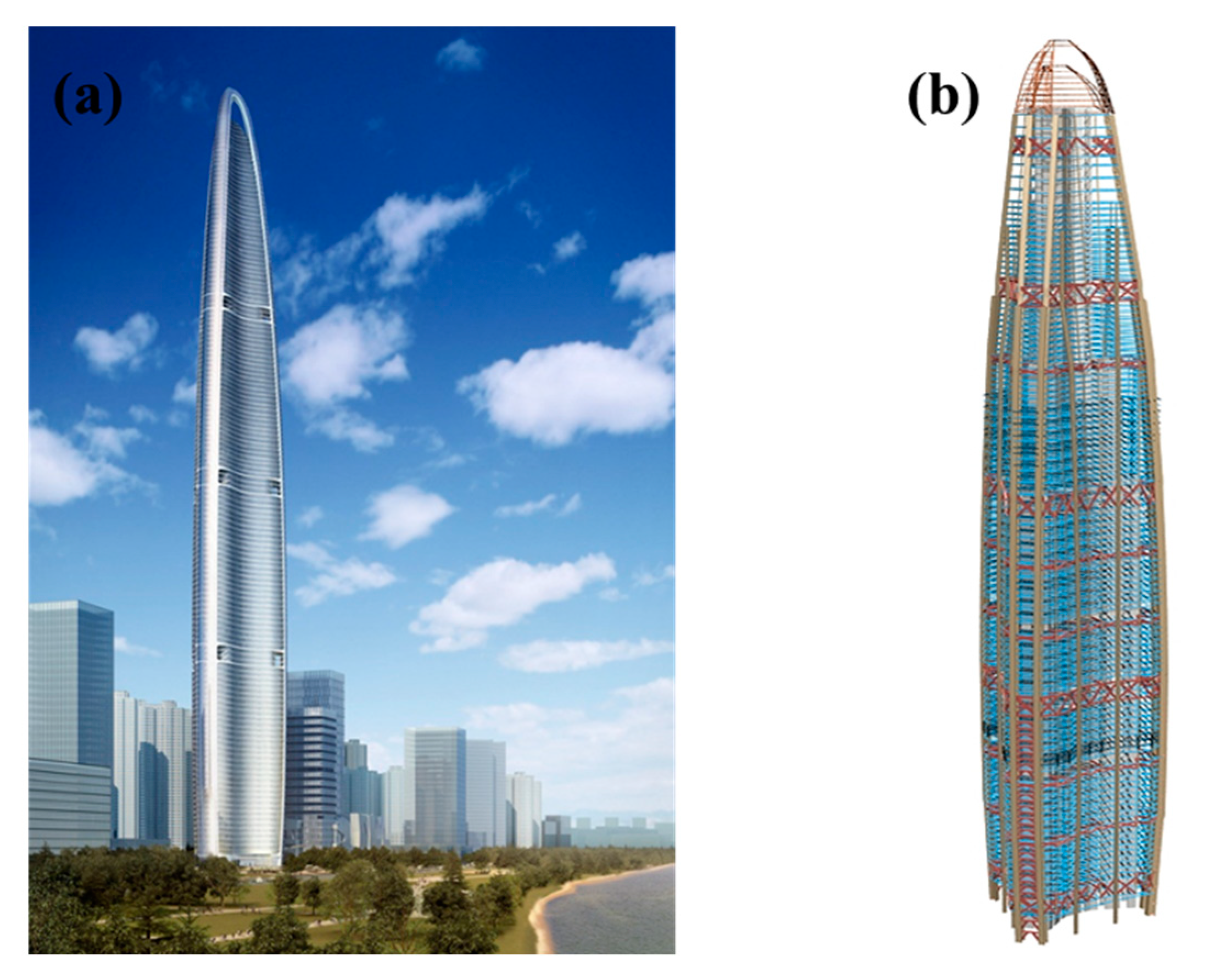
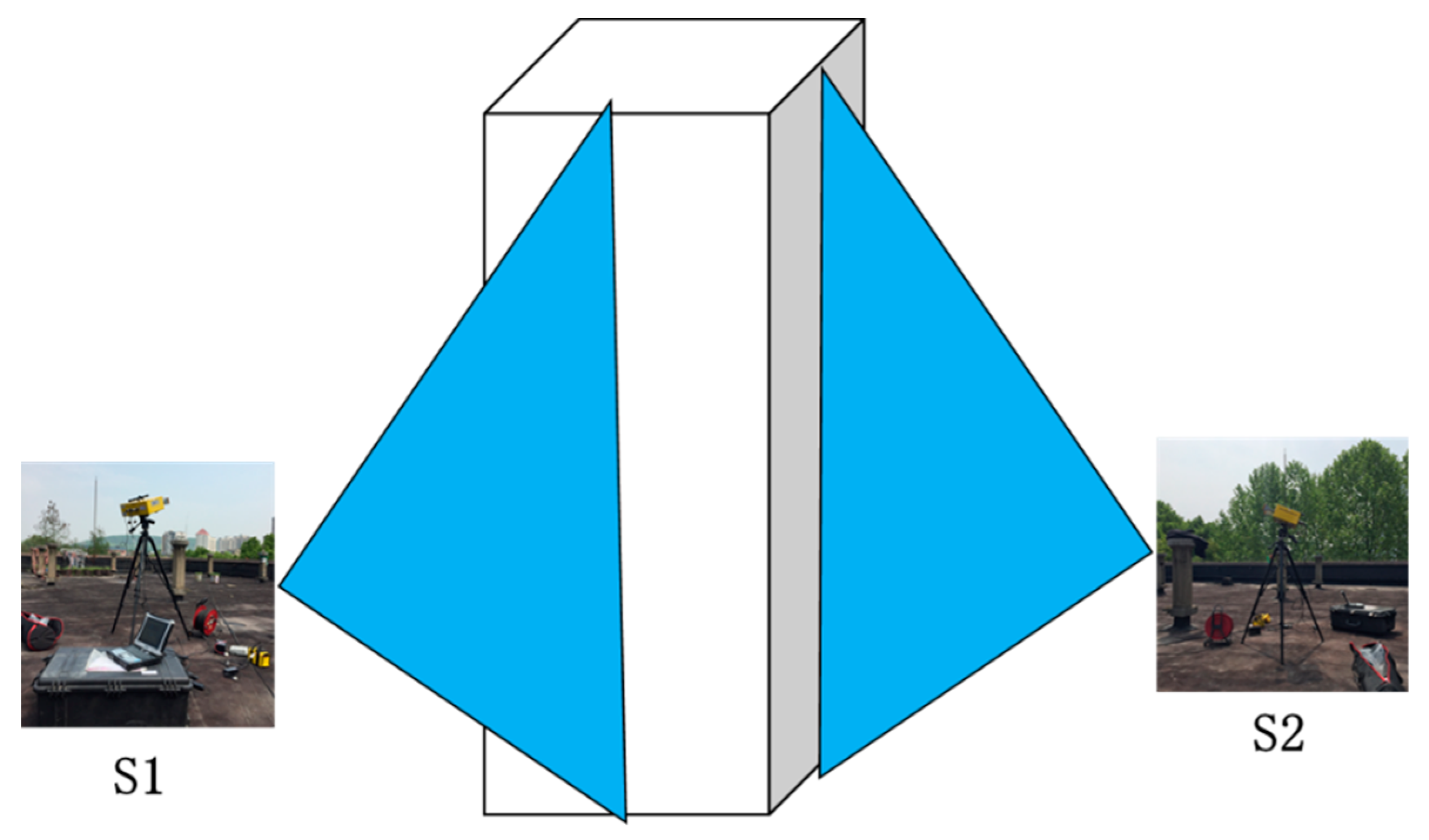
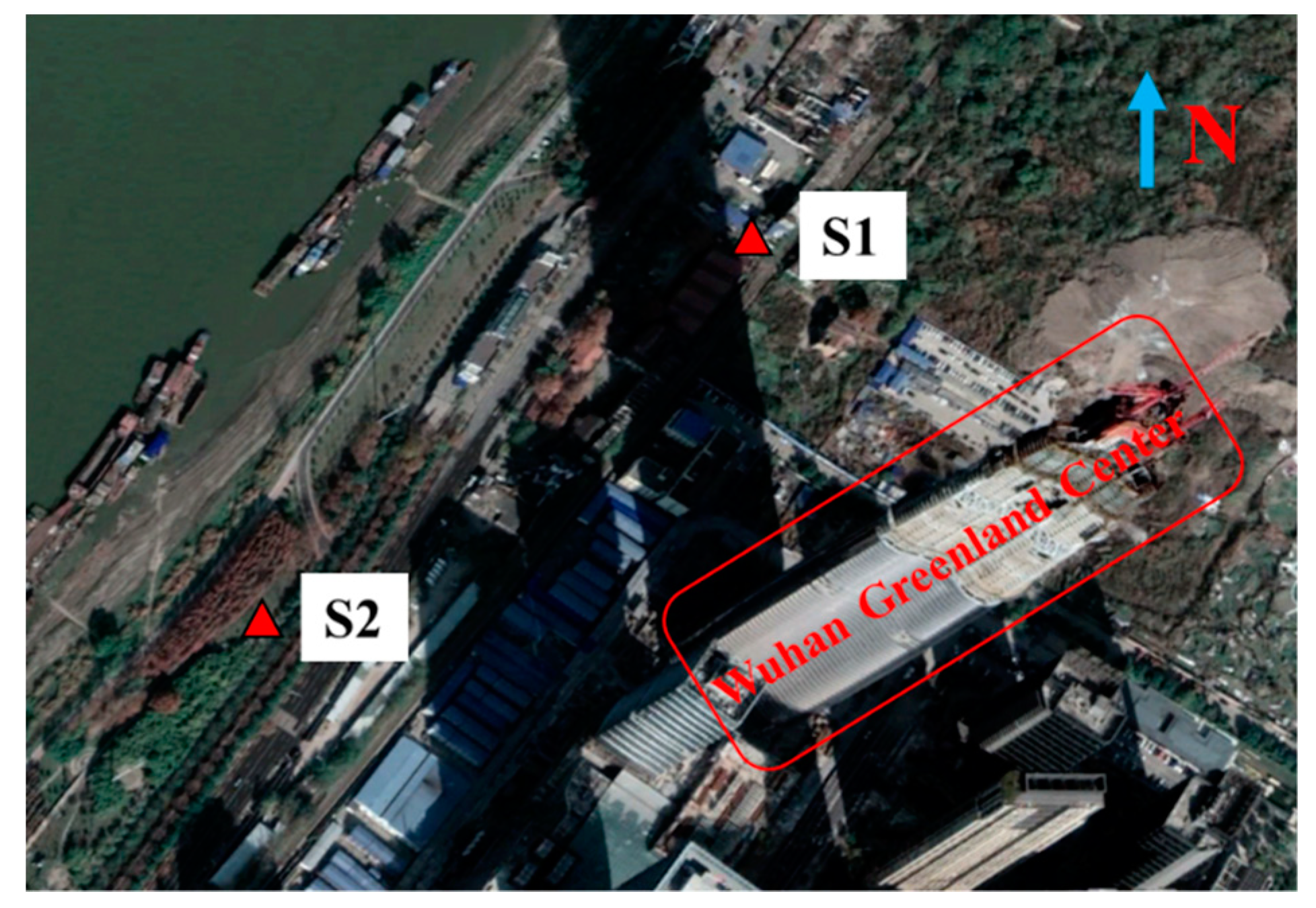

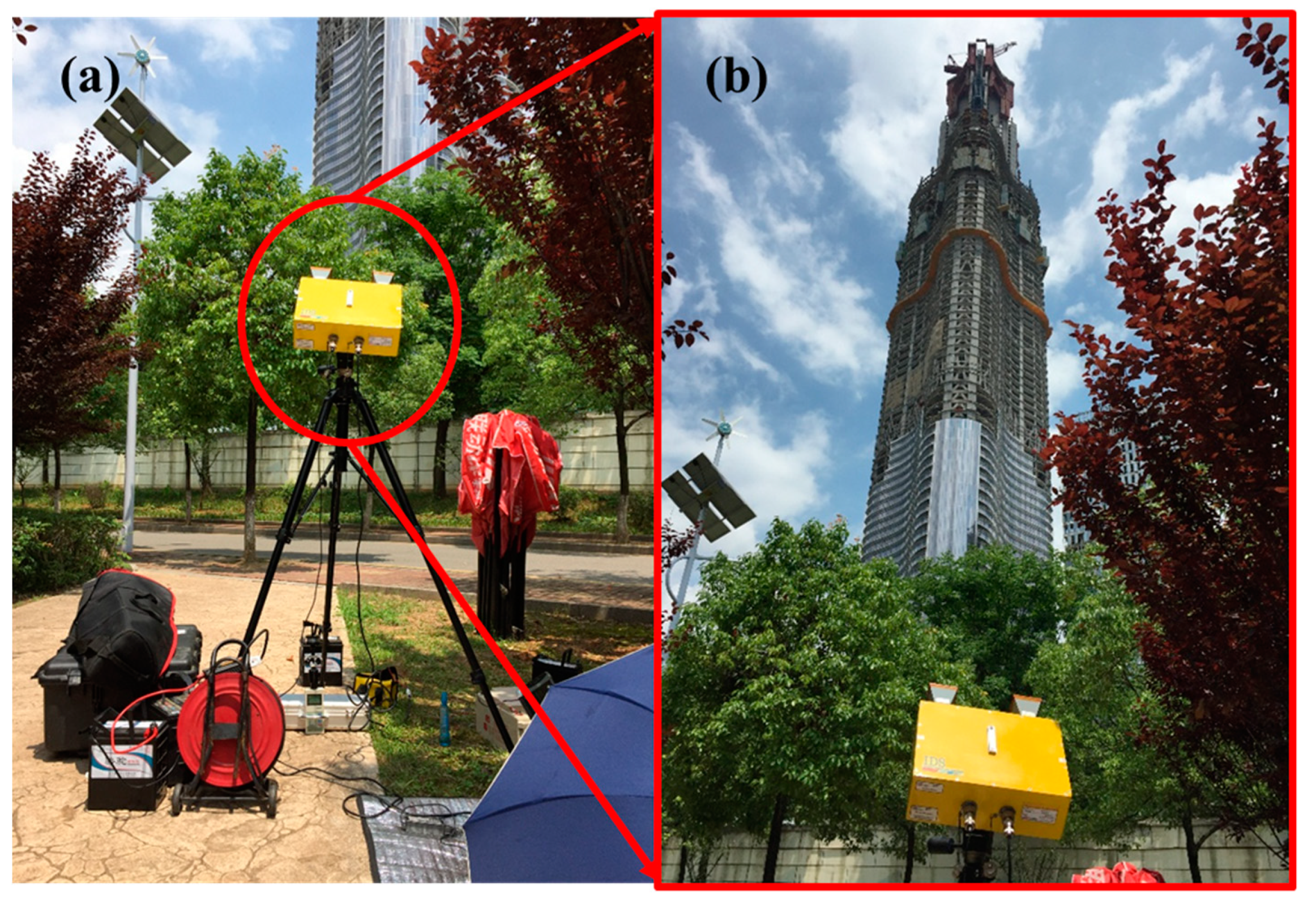
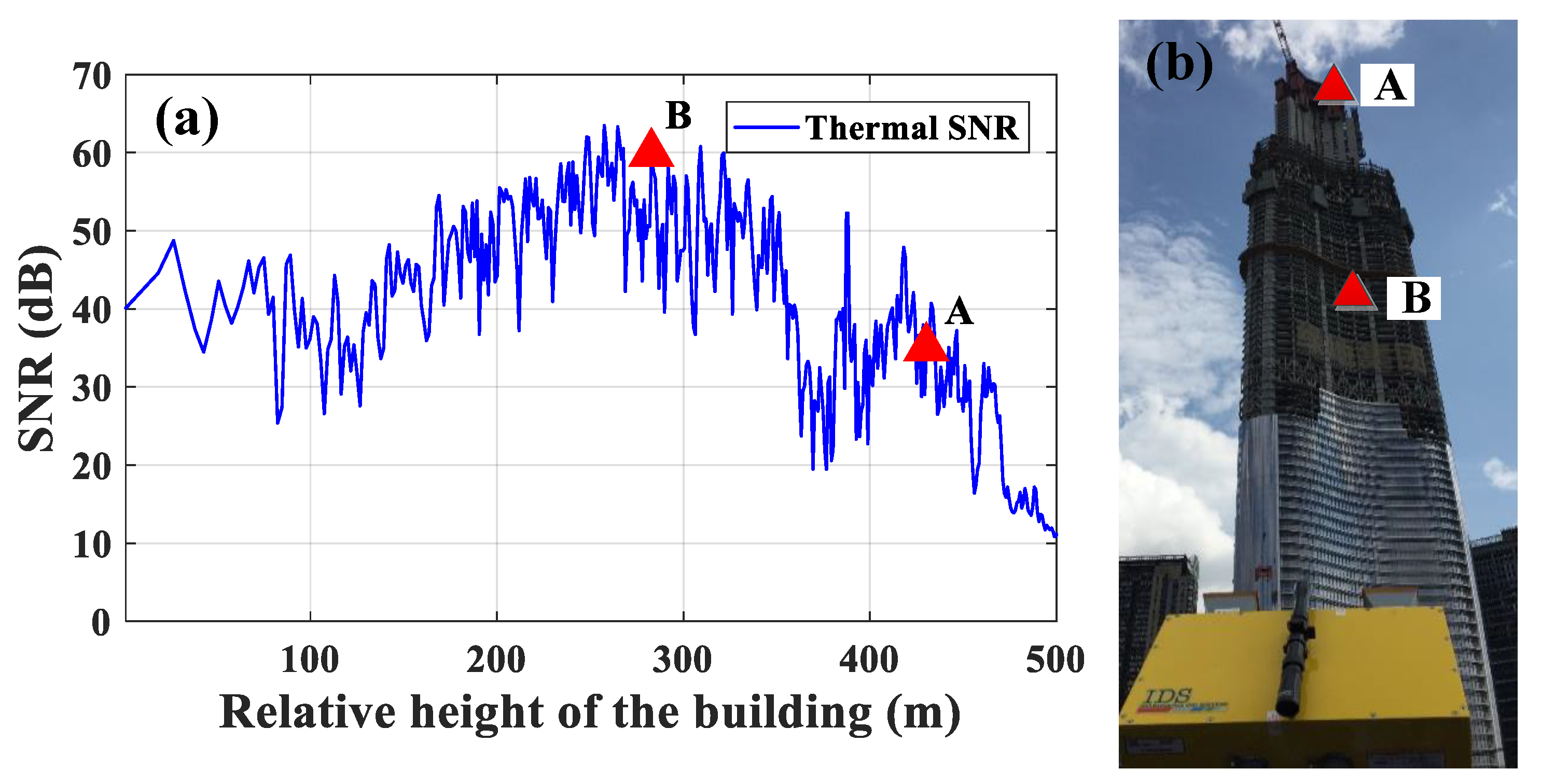
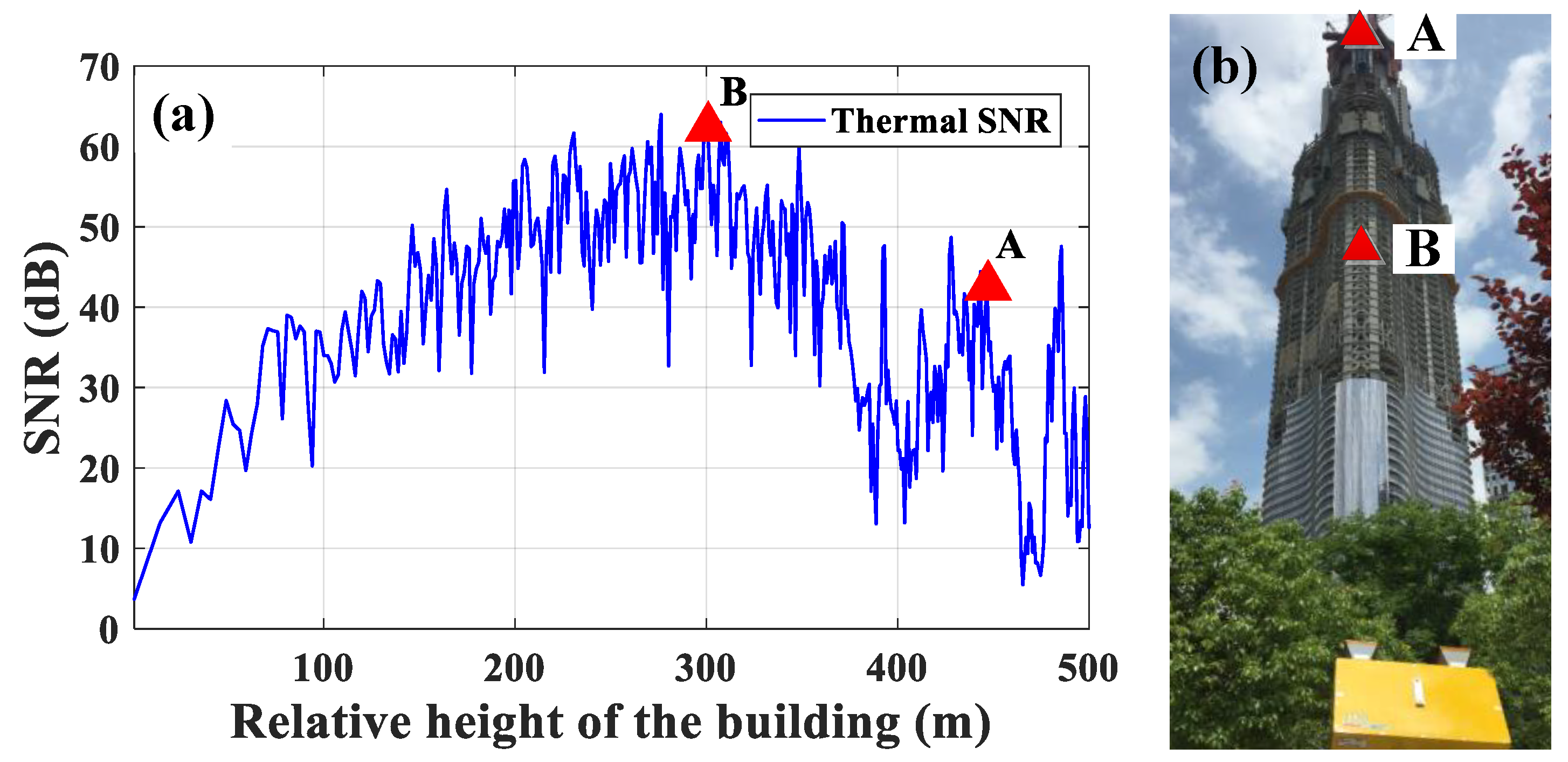
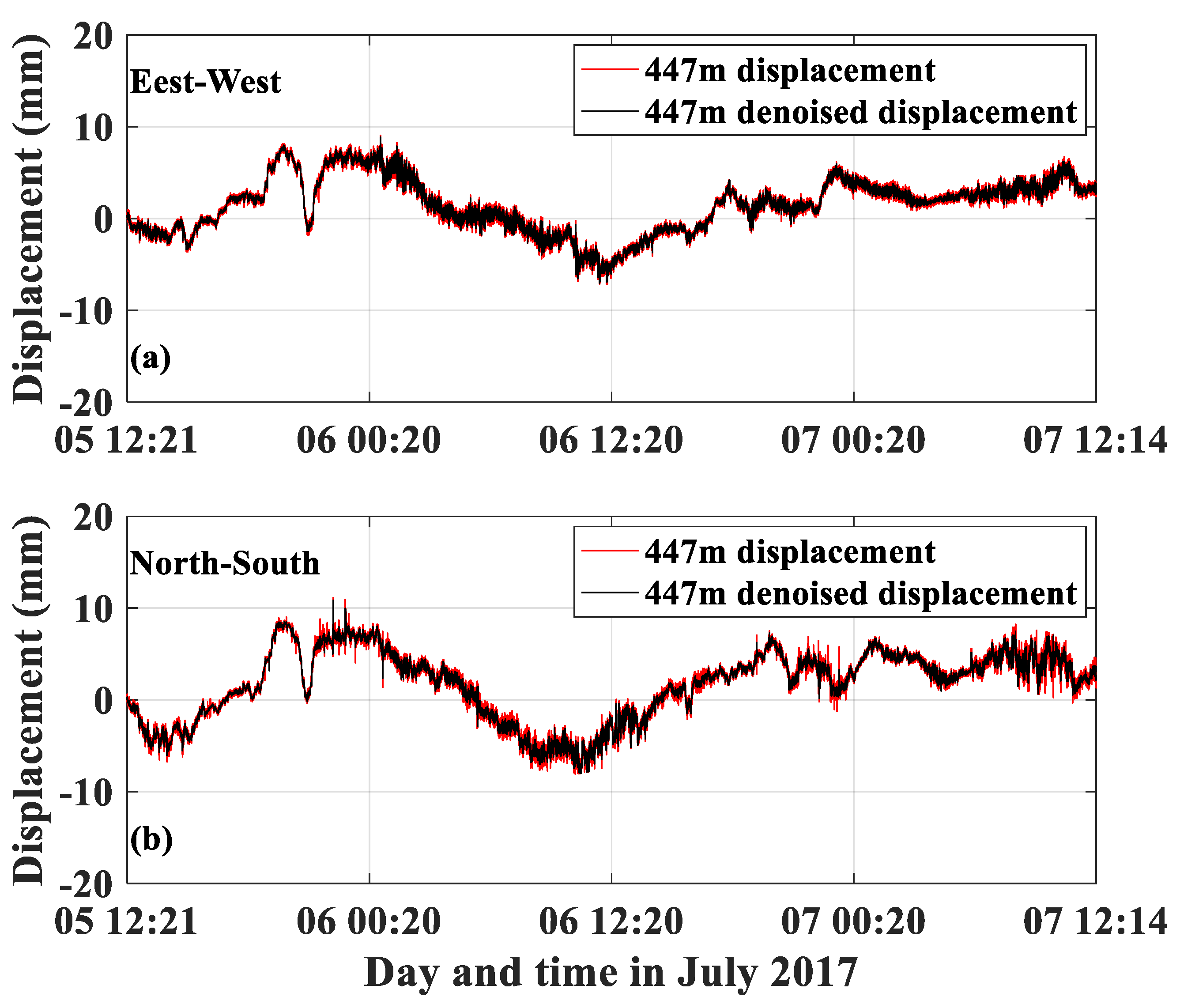
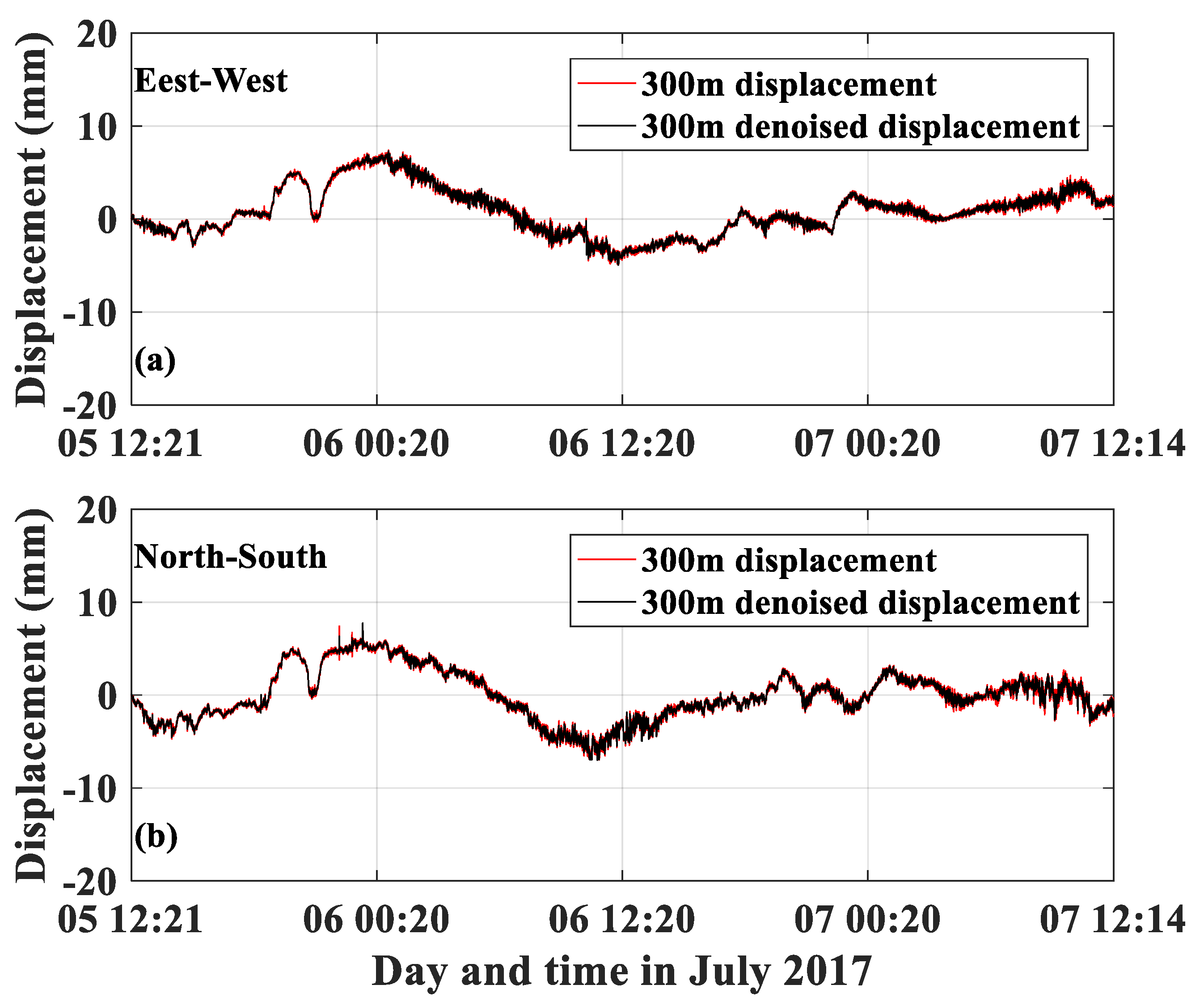


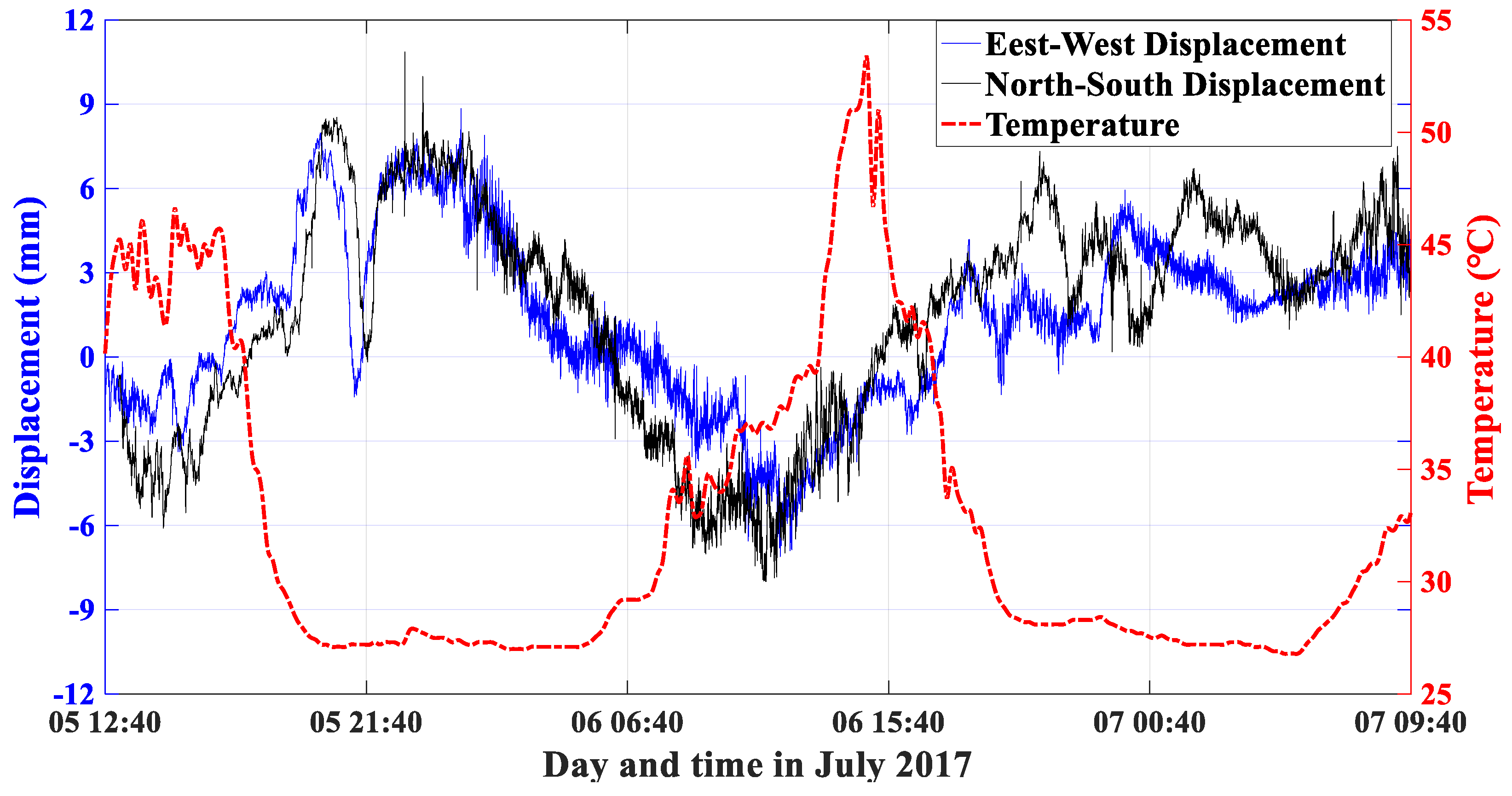
| Parameter | Value |
|---|---|
| Vertical tilt | 50° |
| Antenna type | Type3 (Azimuth 17°, Vertical 15°) |
| Maximum range | 800 m |
| Resolution in range | 0.75 m |
| Sampling | 20 Hz |
| Start time | 12:21 5 July 2017 |
| End time | 12:14 7 July 2017 |
© 2020 by the authors. Licensee MDPI, Basel, Switzerland. This article is an open access article distributed under the terms and conditions of the Creative Commons Attribution (CC BY) license (http://creativecommons.org/licenses/by/4.0/).
Share and Cite
Zhou, L.; Guo, J.; Wen, X.; Ma, J.; Yang, F.; Wang, C.; Zhang, D. Monitoring and Analysis of Dynamic Characteristics of Super High-rise Buildings using GB-RAR: A Case Study of the WGC under Construction, China. Appl. Sci. 2020, 10, 808. https://doi.org/10.3390/app10030808
Zhou L, Guo J, Wen X, Ma J, Yang F, Wang C, Zhang D. Monitoring and Analysis of Dynamic Characteristics of Super High-rise Buildings using GB-RAR: A Case Study of the WGC under Construction, China. Applied Sciences. 2020; 10(3):808. https://doi.org/10.3390/app10030808
Chicago/Turabian StyleZhou, Lv, Jiming Guo, Xuelin Wen, Jun Ma, Fei Yang, Cheng Wang, and Di Zhang. 2020. "Monitoring and Analysis of Dynamic Characteristics of Super High-rise Buildings using GB-RAR: A Case Study of the WGC under Construction, China" Applied Sciences 10, no. 3: 808. https://doi.org/10.3390/app10030808
APA StyleZhou, L., Guo, J., Wen, X., Ma, J., Yang, F., Wang, C., & Zhang, D. (2020). Monitoring and Analysis of Dynamic Characteristics of Super High-rise Buildings using GB-RAR: A Case Study of the WGC under Construction, China. Applied Sciences, 10(3), 808. https://doi.org/10.3390/app10030808






